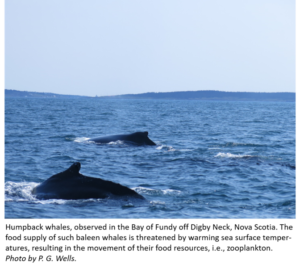 The Regional Association for Research on the Gulf of Maine (RARGOM), a group that annually sponsors a one-day gathering of marine scientists, science managers, and fisheries managers from around the Gulf of Maine and Bay of Fundy, held its 2018 meeting in Portland, Maine, on 26 October 2018. As in previous years, the EIUI research program was represented by Peter Wells. He presented a poster on behalf of the EIUI team, entitled “The science-policy interface for evolving ecosystems: scientific information use in coastal and ocean decision-making.”
The Regional Association for Research on the Gulf of Maine (RARGOM), a group that annually sponsors a one-day gathering of marine scientists, science managers, and fisheries managers from around the Gulf of Maine and Bay of Fundy, held its 2018 meeting in Portland, Maine, on 26 October 2018. As in previous years, the EIUI research program was represented by Peter Wells. He presented a poster on behalf of the EIUI team, entitled “The science-policy interface for evolving ecosystems: scientific information use in coastal and ocean decision-making.”
For further details, check the RARGOM program, which provides abstracts and list of attendees.
The primary messages of the talks given at the meeting included:
Multi-disciplinary partnerships proved to be a crucial element of most of the research presented this year. This approach reflected both the needs for joint funding of projects, as well as the interdisciplinary nature of much of the marine research and its applications in coastal management.
Climate change is having rapid and dramatic effects across the Gulf of Maine, demanding scientific, policy, and management attention. Climate change is illustrated most dramatically by the rapid changes in sea surface temperature and the ongoing heatwaves experienced in regional waters, with dire consequences for fisheries species, seabirds, turtles, marine mammals (e.g., the North Atlantic right whale), and the marine ecosystem as a whole. In this context, read the Fourth National Climate Assessment published by the U.S. Global Change Research Program in November 2018, and note that climate change impacts in the Gulf will be the primary focus of the upcoming Gulf of Maine 2050 Symposium in 4-8 November 2019, Portland, Maine.
Long term data sets and information, especially published as grey literature, are crucial to monitoring ecological change across the Gulf. In the various talks, emphasis was placed on the importance of long-term (decadal) data sets and information, and their appropriate storage and accessibility, e.g., 26 years of nutrient data, and 40 years of data on sand lances. Dr. Tony Diamond’s (University of New Brunswick, Fredericton) work on the population ecology of seabirds on East Machias Island located in the outer Bay of Fundy is another example. He maintains a website for his extensive data files and interpretive data reports (also illustrating the importance of grey literature, a research theme of the EIUI program). Such data and information are crucial for making long-term policy and management decisions on various issues, ranging from fisheries to coastal wildlife conservation.
Citizen science plays an important role in monitoring the ecology and ecological conditions of the Gulf. Two examples were given:
- Monitoring workshops, sponsored by the Northeast Coastal Acidification Network, have been held to address the drivers and effects of ocean acidification. This group maintains the Ocean Acidification Information Exchange.
- An Integrated Sentinel Monitoring Network (ISMN) for Change in Northeast U.S. Ocean and Coastal Ecosystems is coordinated by Jeffrey Runge of the University of Maine. He concluded his presentation by speaking about the necessity to embrace consilience – the linking together of knowledge from different disciplines – to maintain the research programs so essential for monitoring change in the Gulf ecosystem.
The RARGOM meeting was well worth attending. As in previous years, many good contacts were made or renewed. Interestingly, the most insightful comments about the EIUI poster came from a human health policy specialist who was intrigued by the EIUI research approach, seeing similarities to what is needed in the public health field for the communication of information at the science-policy interface.
Author: Peter G. Wells